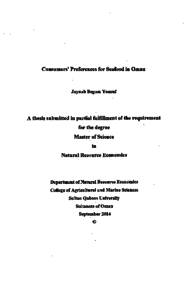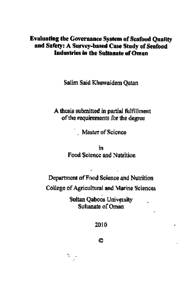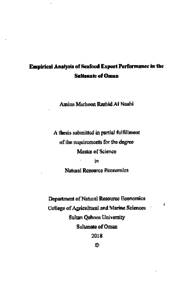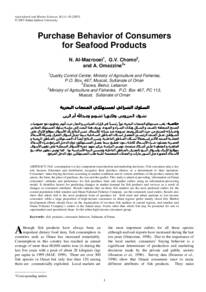Document
Consumers preferences for seafood in Oman
Publisher
Sultan Qaboos University
Gregorian
2014
Language
English
English abstract
Since conventional utility theory does not explain the behavioral factors and attitude behind consumers' preferences and purchasing decision, this thesis aims to determine the various socio economic and behavioral factors in determining the frequency of seafood consumption and the intention to consume seafood (in future) in Oman, It also researches how consumers in Oman perceive quality of seafood. Using a fusion of the Evoked Set and the Theory of Planned Behavior (TPB), the study was conducted through a survey using a questionnaire. A pilot study was steered before executing the survey amongst the students and staff (comprising of 10 participants) of the Sultan Qaboos University. A total of 906 respondents participated from the hypermarkets (Lulu and Sultan Centre), the Seeb fish market (souq) and the Sultan Qaboos University. The econometric analysis is done using binary choice modeling along with descriptive statistics and inferential statistics. The study revealed that consumers perceived quality primarily as 'freshness' and 'appearance'. Moreover, factors such as nationality, education, household size, and income and habit persistence were significant factors in explaining the frequency of seafood consumption. The intention to consume seafood was significantly influenced by habit (previous consumption frequency), the present consumption frequency along with the attitude towards eating seafood, The results suggest that the seafood industry could create segmentation in terms of seafood for Omanis and non-Omanis since there is a distinct difference in the preferences for the type of seafood among the two groups of respondents. Also, habit was found to be persistent from one time period to another. Respondents carried the preference for and frequency of seafood consumption from the past to the present and also hoped to continue the same pattern in the future. This could lead to habit formation where a diversion in the peoples' preference could be created by encouraging them to try different types of seafood rather than sticking to their favorite. This not only reduces pressure on the usual and general favorite species (e.g. Kingfish), but also creates diversification in peoples' preferences and brings other non-popular seafood species into limelight.
Respondents did not seem to be very much aware of the health benefits of seafood consumption. This is where the role of the Ministry of Health (MOH) and the Ministry of Agriculture and Fisheries (MOAF) comes into play in spreading knowledge, information and awareness about the various benefits of seafood consumption through educational and media related platforms. Quality of seafood needs to be restored and maintained by the use of proper storage and transportation facilities, and also with the use of ice right from the time seafood is caught till they are consumed. Lastly, traceability of seafood is becoming an increasing concern amongst consumers due to questionable quality of seafood being imported from other countries, Moreover, people are still skeptical about farmed/aquacultured fish in terms of their quality. Respondents suggested that seafood could be labeled as wild or farmed. All the more, this information would have some implications on the aquaculture industry which is still facing some skepticism in terms of product safety concerns.
Description
Thesis
Member of
Resource URL
Arabic abstract
بما أن نظرية المنفعة التقليدية لا تفسر العوامل السلوكية وراء موقف تفضيل المستهلكين وقرار الشراء لديهم، فإن هذه الأطروحة تهدف إلى تحديد مختلف العوامل الاقتصادية والسلوكية الاجتماعية في تحديد وتيرة استهلاك الماكولات البحرية و عزم المستهلك لاستهلاك الماكولات البحرية في المستقبل في عمان. بالإضافة إلى ذلك فإن الأطروحة أيضا تناقش كيف ينظر المستهلكين في عمان إلى جودة المأكولات البحرية باستخدام مزيج من مجموعة إيفوك ونظرية السلوك المخطط، فقد أجريت الدراسة من خلال مسيح باستخدام الاستبيان. وقد تم اجراء دراسة تجريبية قبل تنفيذ المسيح بين الطلبة والموظفين (تتألف من 10 مشاركا) من جامعة السلطان قابوس. وشارك ما مجموعه 906 من المشاركين في محلات السوبر ماركت (اللولو ومركز سلطان)، سوق السمك السيلية (سوق) وجامعة السلطان قابوس. تم التحليل الاقتصادي القياسي باستخدام النمذجة ثنائية الاختيار مع الإحصاء الوصفي والإحصاء الاستنتاجي. وكشفت الدراسة أن المستهلكين ينظرون إلى الجودة في المقام الأول من خلال "نضارة" و "مظهر" المنتج. وعلاوة على ذلك، فإن الدراسة كشفت عن وجود عدة عوامل هامة ساهمت في شرح سلوك المستهلك في تكرار استهلاكه للمأكولات البحرية اشتملت هذه العوامل على الجنسية، والتعليم، وحجم الأسرة، والدخل وعادة الاصرار لدى المستهلك عزم المستهلك الاستهلاك الماكولات البحرية تأثر بشكل كبير بسلوك و عادة المستهلك (تكرار الاستهلاك السابق)، و وتيرة الاستهلاك الحالي جنبا إلى جنب مع الاتجاه نحو تناول المأكولات البحرية. تشير النتائج إلى أن قطاع الماكولات البحرية يمكن ان يخلق التفرقة من حيث المأكولات البحرية المفضلة لدى العمانيين وغير العمانيين حيث أن هناك فرق واضح في تفضيلات أنواع الماكولات البحرية بين المجموعتين من المشاركين. أيضا، وجد أن سلوك المستهلك و العادة لديه قد تكون دائمة و مستمرة من فترة زمنية إلى أخرى. حيث أن المشاركين اقروا أن مدى استهلاكهم للمأكولات البحرية و تفضيلهم لأنواع من بين انواع هو سلوك ثابت و قائم على قرارات استهلاكهم في السنوات الماضية وايضا يأملون أن يستمر نفس النمط في المستقبل. هذا يمكن أن يؤدي إلى تشكيل نمط سلوكي و عادة عند المستهلك، حيث يمكن إيجاد نوع من التغيير في تفضيل المستهلكين للأسماك من خلال تشجيعهم على تجربة انواع مختلفة من المأكولات البحرية بدلا من التمسك بالأنواع المفضلة لديهم. وهذا لا يقلل الضغط على الأنواع المفضلة المعتاد والعامة (مثل الكنعد) فقط، ولكن أيضا يخلق التنويع في تفضيلات الناس ويسلط الضوء على أنواع أخرى للماكولات البحرية غير الشعبية نتائج الدراسة أظهرت أيضا أن الفئة المستطلعة لم تكن على دراية كبيرة بالفوائد الصحية لاستهلاك الماكولات البحرية من هنا يأتي الدور الهام لوزارة الصحة ووزارة الزراعة والثروة السمكية معا في نشر المعرفة والمعلومات والوعي حول الفوائد المختلفة الناتجة من استهلاك المأكولات البحرية من خلال برامج تعليمية ووسائل الإعلام ذات الصلة, للحفاظ على جودة الماكولات البحرية يجب أن تستخدم مرافق التخزين والنقل المناسبة كما يجب استخدام الثلج في تخزينها من ساعة صيدها إلى أن يتم استهلاكها. وأخيرا وليس آخرا، فإن تتبع مصدر هذه الماكولات البحرية أصبح يشكل مصدر قلق متزايد في أوساط المستهلكين نظرا الوجود شكوك حول جودة المأكولات البحرية التي يتم استيرادها من بلدان أخرى. وعلاوة على ذلك، فإن الناس لا يزالون يشككون في جودة ما يتم استزراعه من ماكولات بحرية. واقترح المستطلعون في الاستبانة أن الماكولات البحرية يمكن أن توصف بأنها بحرية أو مستزرعة. اضافة لذلك فإن هذه المعلومات يمكن أن يكون لها بعض الآثار المترتبة على مجال الاستزراع الذي لا يزال يواجه بعض الشكوك من حيث سلامة المنتج
Category
Theses and Dissertations




